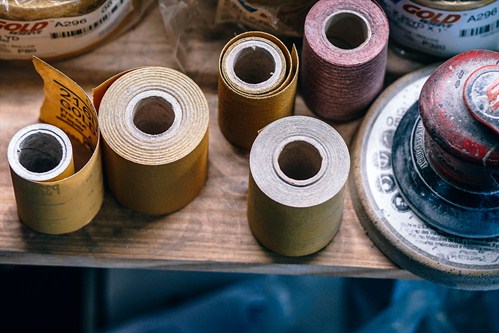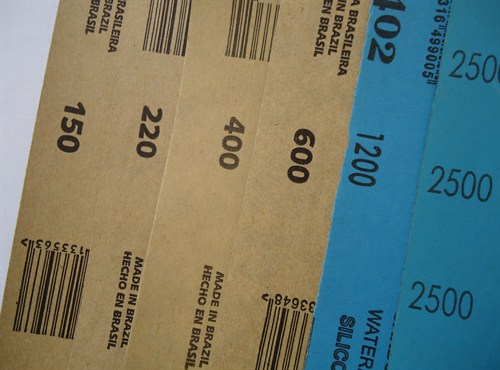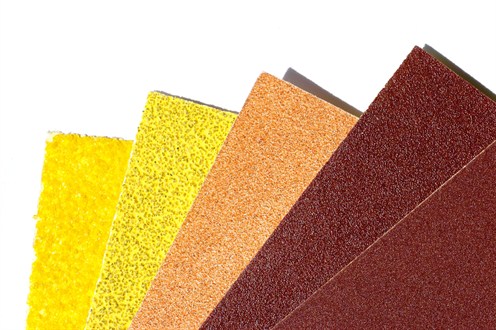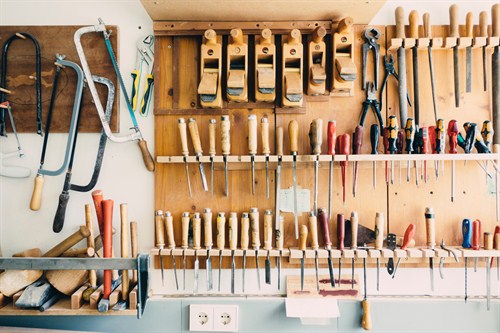Getting started is the hardest part of any project.
But for woodworking, it's actually quite simple. Grab some sand
paper and try your best to avoid making a huge mess. However, there
are so many different kinds of sandpaper. Which leaves us with this
question. Which type of sandpaper should you use?

Choosing the Right Grit
Sandpaper works by scratching away defects with
thousands of tiny abrasive particles. The lower the number, the
coarser the grit; and the higher the number, the finer the
sandpaper. Most homeowners will never use grits at the top or
bottom of the scale.
Sandpapers are commonly graded as:
Extra Coarse (12-24
grit): Very uncommon to be used for a homeowner. Used for
very rough work, heavy machines, wood floors, etc.
Coarse (30-50 grit): A good choice
for rough sanding and removing stock quickly, such as sanding the
edge of a sticking door with a belt sander.
Medium (60-100 grit): Makes a
good starting point for most projects, from sanding unfinished wood
to removing old varnish.
Fine (120-180 grit): Great for
removing the scratches left by coarser grits on unfinished wood and
for lightly sanding between coats of paint.
Very Fine (220-300 grit): Used
for light sanding between coats of finish and to sand metal and
other hard surfaces.
Extra Fine (320-400
grit): Same as very fine, unlikely to be used for a
homeowner.
Super Fine (400+
grit): Same as very fine, unlikely to be used for a
homeowner.
*Note: Sandpaper is graded commonly graded by
CAMI and FEPA. Numbers will vary.

Types of Abrasives
There are six main types of sandpaper, and they
all have various uses.
Garnet: Best
used for hand sanding. Suitable for sanding bare wood. Dulls
quickly.
Emery: Excellent for hand or
power sanding metal. Can also be used to polish metal. You can
often find Emery sandpaper on flexible cloth backing.
Ceramic: Used primarily on
belts and discs for power sanding. Used for aggressive material
removal on wood.
Silicon carbide: One of the
best types, but wears fairly quickly. Has many uses, including
wood, plastic and metal.Can be used for wet
sanding.
Aluminum oxide: Common
sandpaper. Great for power or hand sanding on wood, paint, drywall
or metal. Lasts longer than most.
Zirconia alumina:
Suitable for wood, fiberglass, metal and painted surfaces.
Typically used with belts, pads and discs for power sanding. Lasts
decently long.

But wait… There's More!
You may see sandpaper that is called "open-coat"
or "closed-coat".
"Open coat" papers have more space between each
abrasive particle, so they don't clog as quickly with dust. Coarse
grits are typically open coat.
In grits finer than 150, where clogging is less
of a problem, most sandpapers are "closed coat," covered completely
with abrasive. Hardwoods and metals can be sanded with closed-coat
papers.
As a general rule, open-coat is typically better
for woodworking, as it clogs less often, particularly when working
with softwoods like pine.

Tips and Tricks
-
If it looks bad-it
probably is. This same principle applies to your hands. Run
your hands over what you are sanding. It is amazing what you
can feel that you cannot necessarily see. Working with wood is
about as much feel as it is sight.
-
Sanding with the grain of the wood is generally
preferable to sanding against it. You can definitely take
more off if you are sanding with power tools by going
cross-grain-but if you are hand sanding,
with the grain is the way to go.
-
For really odd-shaped edges, make some sanding
sticks. Choose differently shaped dowels and attach sandpaper to
them with staples or double-sided tape.
-
The golden rule of sanding is to start with a
grit coarse enough to quickly remove surface imperfections and
follow with incrementally finer grits. Each successive grit erases
the scratches of the coarser one before, until the scratches
themselves become undetectable to the eye and the touch.
-
Sponge-backed sandpapers are helpful when
working with pieces that have round or uneven
edges.
-
After sanding your woodworking project, you need
to remove all traces of sawdust before you're able to apply the
paint or stain finish of your choice.
If you want even more information and details,
check out these helpful sites. See you next
Friday!
The Spruce,
Lowes, Home
Fixed,
The
Engineering Toolbox.